
The Technics SA-700 receiver debuted in 1978 and was at the higher end of the Technics receiver lineup at the time. It’s rated at a hefty 100 watts per channel and retailed for a price of $700. With style, numerous features, and power to spare, the SA-700 fits well into any vintage audio setup.
The SA-700 has the signature Technics look with brushed aluminum faceplate, warm dial lighting, and especially the recessed black out knobs and switches. Technics did introduce a sign of things to come with the use of LED’s for the power meters even though the tuning meters are analog.
Technics’ receiver lineup in 1978 was extensive and included the SA-200, SA-300, SA-400, SA-500, SA-600, SA-700, SA-800, and the monster SA-1000. Here are the rated watts per channel and retail price for each model:
- SA-200 – 25 wpc – $240
- SA-300 – 35 wpc – $300
- SA-400 – 45 wpc – $360
- SA-500 – 55 wpc – $430
- SA-600 – 70 wpc – $530
- SA-700 – 100 wpc – $700
- SA-800 – 125 wpc – $800
- SA-1000 – 330 wpc – $1700
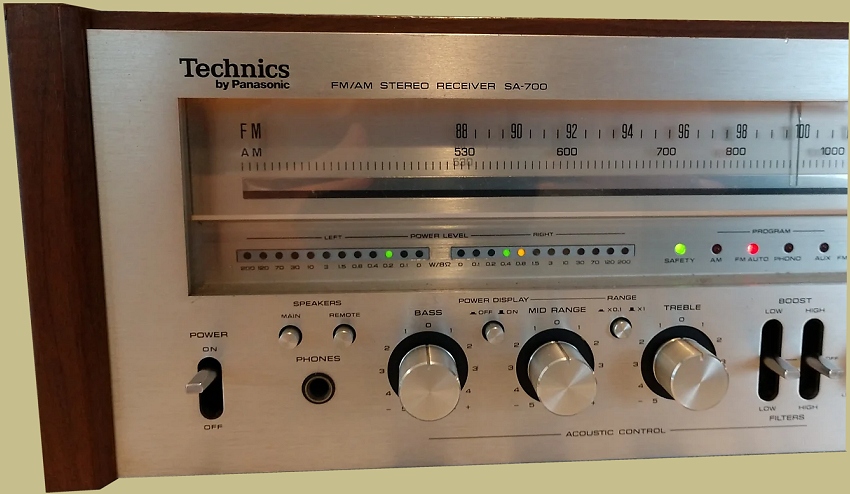
Front Panel
The front panel of the SA-700 has many of the standard controls and a couple that are more nuanced. It has bass, treble and mid range tone controls as well as low and high filters. There are also switches for loudness and muting. The tone, volume, and balance knobs are all click stop controls. There are two analog tuning meters, including signal-strength for FM and AM and center channel for FM, and two LED power meters. There is also a headphone jack.
The muting switch has a double-muting action, applied both in the IF stage and after the MPX stage, which provides a smooth transition between mute and non-mute conditions, without the loud thumps often heard in muting circuits.
The power meters on the SA-700 utilize a string of 24 LEDs, 12 per channel, to visually indicate power output in real time. The LEDs illuminate progressively as power increases – first green, then orange, finally red. Flashing red LEDs signify approaching maximum output and the onset of audible clipping distortion. The LED sensitivity can be increased tenfold with the range switch to better assess channel balance and separation at low volumes. The meters are useful because they warn the listener before clipping distortion occurs, as well as demonstrate both channel balance and dynamic headroom. Plus they look very cool.
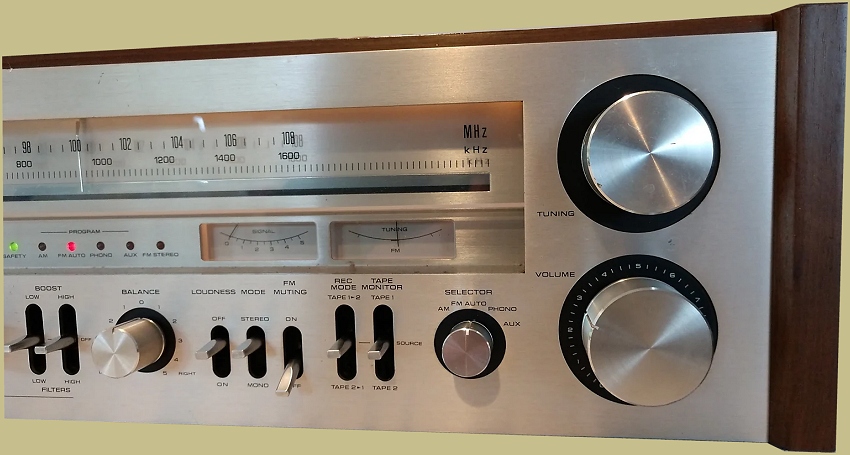
Acoustic Control
The SA-700 receiver incorporates what Technics called the Acoustic Control system. It goes beyond conventional tone controls to provide more flexibility in tailoring the tonal balance. This is achieved through a combination of low-distortion Baxandall bass, midrange, and treble controls working in conjunction with bass and treble filter switches.
The bass filter switch introduces a 100Hz peak that emphasizes drums and low instruments. Adjusting the bass control shifts the location and amplitude of this peak, enabling a wide range of boosted or attenuated bass responses. Likewise, the treble filter switch creates a shelving response that brightens high frequency overtones.
In the filter positions, the switches apply 6dB per octave roll-offs starting at 100Hz and 7kHz respectively. This filtering removes unwanted subsonic noise from records or excessive high frequency content.
The acoustic controls can be used individually or in combinations to achieve subtle tonal changes. For example, cutting muddy bass while boosting crisp highs could add clarity. Or, attenuating fatiguing highs while filling out thin lows might yield a smoother, warmer sound. The Acoustic Control system makes customizable tone shaping easy.
Here are graphs of the tone controls effects.

Here are the Acoustic Control settings as described in the manual:
Boost/filter selectors: These selectors can be used to select the characteristics of change of the low-sound range and high-sound range adjusted by using the tone controls.
BOOST: When the “LOW” switch is set to the “BOOST” position, low-range sound is emphasized (“boosted”) in the 100-Hz range. When the “HIGH” switch is set to the “BOOST” position, high-range sound is emphasized in the 10-kHz range. The amount of actual emphasis will differ depending upon the settings of the bass and treble tone controls, but the maximum level of the emphasized range will be the same as when the tone controls are set to their maximum positions (5+). When listening to music with a strong beat, such as rock, set both switches (“LOW” and “HIGH”) to this position.
OFF: When the switches are set to this position, the boost and filter functions are turned off.
FILTER: When the “LOW” switch is set to the “FILTER” position, low-range sound of 100-Hz and lower is cut. When the “HIGH” switch is set to the “FILTER” position, high-range sound of 7-kHz and higher is cut. Set the “LOW” switch to this position to eliminate low-range noises such as motor rumble, and set the “HIGH” witch to this position to eliminate high-range noises such as tape “hiss” noise, etc.
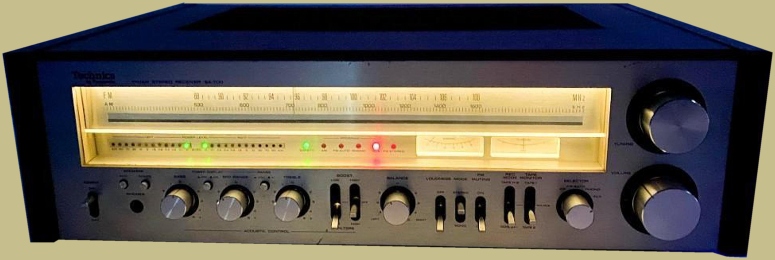
Tuner
The SA-700 has a Mirror-reflection FM/AM tuning scale which gives it a visual look of depth. In terms of performance the FM tuner achieves excellent reception through high-performance RF components, optimized IF filtering, linear demodulation, and ultra-flat frequency response.
The front end employs a low-noise/low-capacitance dual-gate MOSFET for RF amplification along with a junction FET buffer between the mixer and local oscillator. This arrangement provides superb sensitivity, selectivity, and interference rejection.
The IF section contains five stages with three “Flat Group Delay” ceramic filters. Their excellent phase response ensures hi-fi sound quality while providing 80 dB selectivity. Differential amplifiers in ICs deliver uniform gain and AM suppression.
At the heart of the tuner is a high-linearity quadrature detector. Its broad peak-to-peak range enables wide, linear frequency response even with excessively modulated stations. This prevents distortion or treble loss.
A phase-locked loop (PLL) IC in the multiplex decoder locks onto the broadcast signal for solid stereo separation across the entire audible spectrum.

Here are the specifications for the SA-700 from the manual.

There is also a Technics SA-700K version with a black cabinet and black faceplate. It was most likely sold in Europe and not the U.S.
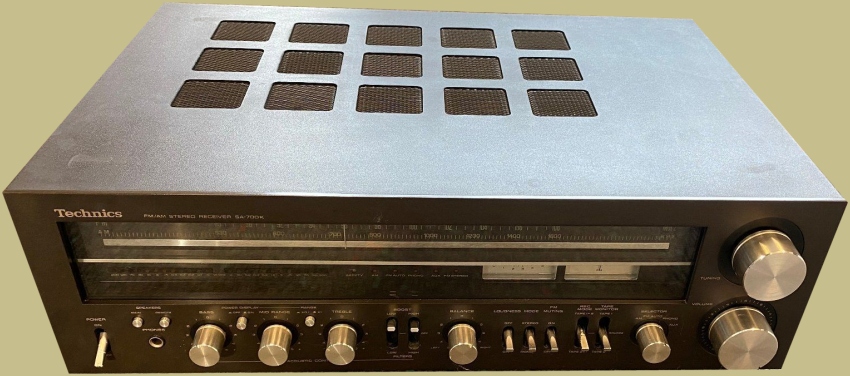
Amplifier
The Technics SA-700 stereo receiver is capable of producing 100 watts per channel continuous power into 8 ohm loads with less than 0.04% total harmonic distortion from 20Hz to 20kHz. It can briefly generate higher power output to reproduce musical peaks accurately.
The SA-700 has a large, well-regulated power supply with a sizable transformer and 15,000 uF electrolytic capacitors on each side to maintain stability when driving dynamic music and deep bass.
A current-mirror loaded differential stage in the SA-700 doubles the gain without increasing noise and distortion by using thermally matched transistor pairs immune to temperature changes.
The output stage utilizes a parallel push-pull complementary design with four high-power transistors per channel in an OCL configuration for low-distortion bass.
The phono preamp has a very good 95dB signal-to-noise ratio and can handle up to 200mV RMS input at 1kHz before overload. It uses a separate power supply and low-noise transistors to minimize noise.
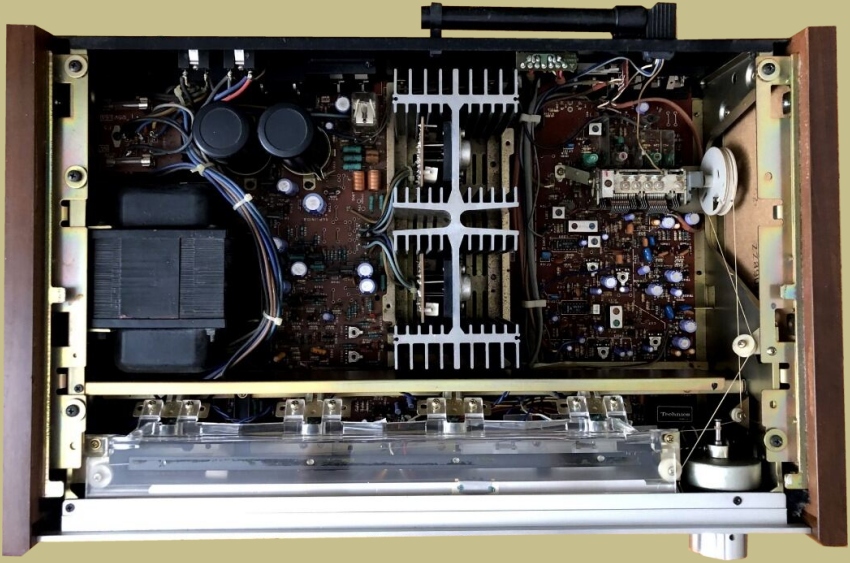
Rear Panel
The rear panel of the SA-700 has connections for a turntable, auxiliary device, and two tape decks. There are Pre-Out/Main-In terminals which are useful for adding external processors such as an equalizer or for separate use of the preamplifier or power amplifier sections.
When two tape decks are connected, you can record from either deck to the other. And you can listen to another sound source (such as a record or the tuner) while dubbing is in progress.
There are terminals for two sets of speakers. The two AC outlets consist of one switched and one un-switched. The fuse block for the speaker protection circuit has two fuses which are both 6.0 amp 125 volt fuses.

Reviews
A pleasure to listen to – great FM section.
Monster receiver with superb build quality. Fit and finish is outstanding and the lighting is very sharp against the aluminum face.
I love this reliable, well-built receiver.
Just bought one and luv it, it sounds great.
I have several vintage amps, but this guy is the prime.
Hands down the best receiver I’ve ever owned. Nothing I’ve bought since has come close to the loudness and clarity of sound this beast has.
I find my SA-700 to be very clean sounding, almost to the point of being sterile.

Is the Technics SA-700 a good receiver? Absolutely. Here are some of the reasons it’s so good.
- 100 watts per channel
- LED power level indicators
- Excellent low frequency (bass) production
- Comprehensive Tone controls, including Mid Range
- Advanced Acoustic Control including Boost Controls
- Can be used as pre-amp or power amp
- Excellent FM Stereo reception
- Cool Technics styling
If you’re looking for a mid to high powered vintage receiver then any of the Technics models from the SA-500 to the SA-800 will do the job. Of course, the monster SA-1000 would as well but prices on those are sky high now. The SA-700 really provides all the value you’d need at a reasonable price.
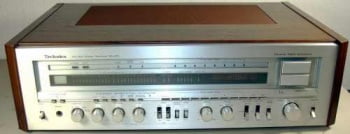

I LOVE Technics, the best you can get for any price. I just lost a channel after 35 years of playing. People came to my house to listen to tunes like I was having a concert. I kept back-up machines around, esp. the turntable and receiver. I don’t regret it at all. Makes living life better every day!
I have a SA-700 can’t get any sound out of speakers can’t figure it out was working good at one time now nothing. Anyone have a suggestion thank you.
I have a 500 that I bot in Memphis, Tn. in the fall of 78. Has always worked and sounded great. Going on 50 yrs old. Great quality. The lights are burnt out, but used a great link in this article to purchase replacements.